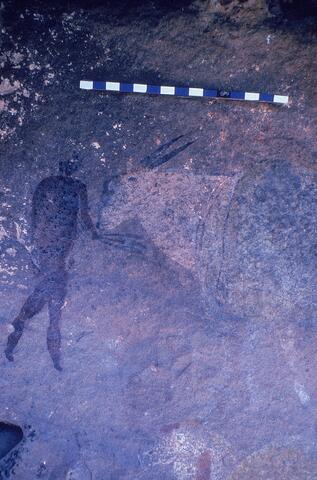Identity area
Reference code
Title
Date(s)
Level of description
Extent and medium
Context area
Name of creator
Biographical history
Brief description of site: This 'site' is, in fact, a series of rock-paintings located along 160 m of rocky krantz line. The general aspect is ENE to NE. There is dense vegetation and the floors of the shelters are mostly rock with pockets of flood-washed deposit. The bottom krantz stratum is a crumbly mudstone overlain with harder quatzitic sandstone. There are many areas where rock has collapsed, often forming shelters. 4 artificial driplines - installed by the Rudners in 1966/1967 are still visible in one of the shelters but their effectiveness is now zero.
A huge but 'messy living area with very few visible lithics because these are washed away by flooding and also trampled by cattle and sheep that walk along the rivers and shelter in the krantzes. There are numerous lower grindstone patches, indicative that this was once a major centre for the San of the area.
Brief description of art: The sites were visited by George William Stow, the early traveller, at some point in the 1860s or 1870s as there are three of his copies of the rock-paintings - one in Stow, G.W. & Bleek D.F. 1930. Rock-paintings in South Africa from parts of the eastern Province and Orange Free State. London: Methuen and two in: Rosenthal, E. & Goodwin, A.J.H. 1953. Cave artists of South Africa. Cape Town: A.A. Balkema (photocopies of Stow's copies attached). There are also 2 copies of Camp Siding's art in: Rudner, J. & Rudner, I. 1970. The hunter and his art: a survey of rock art in southern Africa. Cape Town: C. Struik. All of the above copies' original paintings are still intact and in a good condition.
Fenced outlier: The first site encountered is slightly apart from the others to the west and has been fenced in. This site's imagery is extremely faded with very little - bar a few eland and red human figures now being visible.
Medicine Dance Panel: The next set of paintings - on the main krantz proper - comprises a 1.9 m x 1.26 m extended treatment of a San Medicine or Trance Dance, almost exclusively in red pigment. Over 60 human figures are depicted dancing, clapping, bending forward, holding their arms above their heads and also behind their backs and so forth. Some of the human figures are in profile, including one unusual human figure that also has fine red lines painted coming off his body. These fine lines probably represent sweat. There is also a serpentiform motif with comb-like head. To the left above are eland, including one in unusual white-grey infill with red outline. Below these eland are two human figures in comparable pigment and with eland heads and unusual arrows.
Stow's 'shields': The double rows of over 40 'shields' copied by Stow are, in fact, the torsos of seated human figures. This 1.5 m x 0.78 m panel is on a hollow and outward sloping rock surface. It contains an elaborate depiction of a Medicine Dance with at least 4 human figures shown playing the gora or musical bow - a rare subject in the art. There are more than 42 human figures painted in two episodes - an earlier phase of red paint followed by an ochre, mustard, white and black painting phase. Both phases shop trancers, dancers and the Medicine Dance. There is also a tusked serpent that is painted as though emerging from a crack in the rock face. There are at least 4 eland (Tragelaphus oryx) and half-a-dozen smaller antelope.
Man and Eland Panel: Under a low overhang is a 1.7 m x 0.5 m panel in which a human figure holding three arrows appears to touch or 'chuck' an eland under its chin, though this may be the result of accidental juxtapositioning. The eland is painted in an unusual combination of yellow, red, black and white paints. There are at least 14 other eland painted in red & white and yellow & white and 7 human figures painted in white. There is also a large red rain-animal. Many fingerdots
Name of creator
Biographical history
Repository
Archival history
Immediate source of acquisition or transfer
Content and structure area
Scope and content
Appraisal, destruction and scheduling
Accruals
System of arrangement
Conditions of access and use area
Conditions governing access
Conditions governing reproduction
Language of material
- English
Script of material
Language and script notes
Physical characteristics and technical requirements
Original size: 35mm

